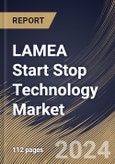Consumers, increasingly conscious of environmental impact and fuel costs, are pivotal in adopting this technology. The rising gasoline and diesel fuel prices and an increasing awareness of climate change have made fuel efficiency a top priority for car buyers. Start stop systems, by reducing fuel consumption during idling, directly contribute to cost savings for consumers and align with their preferences for eco-friendly vehicles. As consumer expectations evolve, automakers are compelled to integrate the technology in high-end models and mainstream and entry-level vehicles. The market response indicates that consumers are willing to embrace this technology as a practical and effective means of achieving better fuel efficiency.
The primary use of start stop technology is to improve fuel efficiency in vehicles. The technology reduces fuel usage by automatically shutting down the engine when the vehicle stops, such as at traffic lights or while idling. In minimizing fuel wastage during inactivity, the engine restarts when the driver releases the brake or engages the clutch. This results in tangible fuel savings for vehicle owners, making start stop tech a valuable tool in addressing the ever-increasing demand for more fuel-efficient vehicles.
In Saudi Arabia’s hot climate, the efficiency and lifespan of vehicle batteries are critical considerations. Thermal management systems are designed to ensure efficient engine cooling, preventing overheating, and maintaining the engine’s performance and durability in Saudi Arabia, which is particularly relevant for vehicles equipped with this technology. In Saudi Arabia’s hot climate, selecting cooling fluids that can endure high temperatures without sacrificing performance is critical for properly operating start stop systems. Thus, due to these aspects, the market will expand across the LAMEA region in upcoming years.
The Brazil market dominated the LAMEA Start Stop Technology Market by Country in 2022, and would continue to be a dominant market till 2030; thereby, achieving a market value of $55.6 Million by 2030. The Argentina market is showcasing a CAGR of 10.1% during (2023 - 2030). Additionally, The UAE market would register a CAGR of 8.9% during (2023 - 2030).
Based on Application, the market is segmented into Passenger Car and Commercial Car. Based on Type, the market is segmented into Belt-Driven Alternator Starter (BAS), Integrated Starter Generator (ISG), Direct Starter, and Enhanced Starter. Based on countries, the market is segmented into Brazil, Argentina, UAE, Saudi Arabia, South Africa, Nigeria, and Rest of LAMEA.
List of Key Companies Profiled
- Continental AG
- Robert Bosch GmbH
- BorgWarner Inc
- Denso Corporation
- Johnson Controls International PLC
- Valeo SA
- Hitachi, Ltd. (Hitachi Astemo, Ltd.)
- Mitsubishi Electric Corporation
- Aptiv PLC
- Aisin Corporation (Toyota Motor Corporation)
Market Report Segmentation
By Application- Passenger Car
- Commercial Car
- Belt-Driven Alternator Starter (BAS)
- Integrated Starter Generator (ISG)
- Direct Starter
- Enhanced Starter
- Brazil
- Argentina
- UAE
- Saudi Arabia
- South Africa
- Nigeria
- Rest of LAMEA
Table of Contents
Companies Mentioned
- Continental AG
- Robert Bosch GmbH
- BorgWarner Inc
- Denso Corporation
- Johnson Controls International PLC
- Valeo SA
- Hitachi, Ltd. (Hitachi Astemo, Ltd.)
- Mitsubishi Electric Corporation
- Aptiv PLC
- Aisin Corporation (Toyota Motor Corporation)








